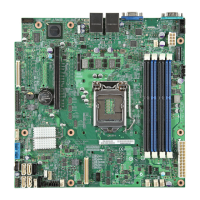Intel® Technology Support Intel® Server Board S1200V3RP TPS
Revision 1.2
changes for power limiting. PMBus*-compliant power supplies provide the capability to
monitoring input power consumption, which is necessary to support NM.
Following are the some of the applications of Intel
®
Intelligent Power Node Manager technology:
Platform Power Monitoring and Limiting: The ME/NM monitors platform power
consumption and holds average power over duration. It can be queried to return actual
power at any given instance. The power limiting capability is to allow external
management software to address key IT issues by setting a power budget for each
server. For example, if there is a physical limit on the power available in a room, IT can
decide to allocate power to different servers based on their usage – servers running
critical systems can be allowed more power than servers that are running less critical
workload.
Inlet Air Temperature Monitoring: The ME/NM monitors server inlet air temperatures
periodically. If there is an alert threshold in effect, ME/NM issues an alert when the inlet
(room) temperature exceeds the specified value. The threshold value can be set by
policy.
Memory Subsystem Power Limiting: The ME/NM monitors memory power
consumption. Memory power consumption is estimated using average bandwidth
utilization information
Processor Power monitoring and limiting: The ME/NM monitors processor or socket
power consumption and holds average power over duration. It can be queried to return
actual power at any given instant. The monitoring process of the ME will be used to limit
the processor power consumption through processor P-states and dynamic core
allocation.
Core allocation at boot time: Restrict the number of cores for OS/VMM use by limiting
how many cores are active at boot time. After the cores are turned off, the CPU will limit
how many working cores are visible to BIOS and OS/VMM. The cores that are turned off
cannot be turned on dynamically after the OS has started. It can be changed only at the
next system reboot.
Core allocation at run-time: This particular use case provides a higher level processor
power control mechanism to a user at run-time, after booting. An external agent can
dynamically use or not use cores in the processor subsystem by requesting ME/NM to
control them, specifying the number of cores to use or not use.
Table 14. Intel
®
Intelligent Power Node Manager 2.0 Capabilities and Features
Capabilities and Features
Power and Thermal
Monitoring
Platform power monitoring
Inlet Air temperature monitoring
Processor package power monitoring
Power Utilization Controls
Dynamic core allocation (core-Idling)
Configure core power off at boot time
Configure power-optimized boot at boot time

